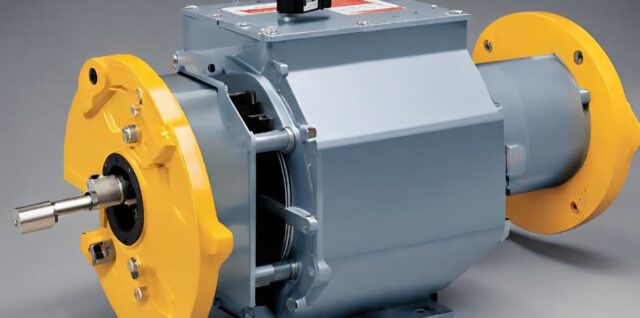In the intricate world of HVAC and industrial systems, where precise control of airflow is crucial, pneumatic damper actuators play a vital role. These unassuming devices are the unsung heroes behind efficient heating, ventilation, and cooling systems. In this blog post, we will delve deep into the realm of pneumatic damper actuators, shedding light on their functions, types, advantages, and applications. We’ll also explore the importance of selecting the right actuator and maintaining its performance.
What Are Pneumatic Damper Actuators?
Pneumatic damper actuators are mechanical devices designed to control the movement of dampers within HVAC and industrial systems. Their primary function is to regulate the flow of air, steam, or other gases by adjusting the position of dampers or valves. These actuators are an integral part of the larger system, contributing to the efficiency and effectiveness of heating, ventilation, and cooling processes.
Types of Pneumatic Damper Actuators
Pneumatic damper actuators come in various types, each suited for specific applications. One common classification is based on the actuator’s operation:
Single-Acting Pneumatic Damper Actuators: These actuators use air pressure to open the damper and rely on a spring to close it when the air pressure is removed. They are commonly used in applications where fail-safe closing is necessary in case of air supply failure.
Double-Acting Pneumatic Damper Actuators: Double-acting actuators use air pressure to both open and close the damper. They offer precise control and are ideal for applications requiring modulating control.
How Do Pneumatic Damper Actuators Work?
Understanding the inner workings of pneumatic damper actuators is essential to grasp their functionality. These actuators consist of key components, including a diaphragm, a spring, and a housing. Here’s how they work:
Diaphragm: The diaphragm serves as the actuator’s central element. It separates the actuator’s two chambers, one filled with air (or gas) and the other connected to the damper. When air pressure is applied or released, it flexes the diaphragm, causing the damper to open or close.
Spring: In the case of single-acting actuators, a spring provides the necessary force to close the damper when the air pressure is removed.
Housing: The housing encases the diaphragm and spring, ensuring proper operation and protecting the components from external elements.
Advantages of Using Pneumatic Damper Actuators
Why opt for pneumatic damper actuators in your HVAC or industrial system? Let’s explore their advantages:
1. Energy Efficiency
Pneumatic damper actuators are known for their energy-efficient operation. They allow for precise control over airflow, ensuring that systems only use the necessary amount of energy.
2. Precise Control
These actuators offer precise modulation, allowing for accurate adjustments in damper positions. This level of control is crucial for maintaining optimal conditions.
3. Reliability
Pneumatic damper actuators are renowned for their reliability and durability. They can withstand harsh conditions and continue to operate effectively over time.
4. Quick Response
These actuators provide a rapid response to changes in air pressure, ensuring that dampers adjust promptly to maintain desired conditions.
5. Maintenance Simplicity
Maintenance of pneumatic damper actuators is relatively straightforward. Regular inspections, lubrication, and cleaning are typically all that’s required to keep them in top shape.
Applications of Pneumatic Damper Actuators
Pneumatic damper actuators find applications across various industries and settings:
HVAC Systems: They are a fundamental component of HVAC systems, controlling the flow of conditioned air in buildings to maintain comfortable indoor environments.
Industrial Processes: Pneumatic damper actuators are used in industrial settings to regulate the flow of gases or steam in manufacturing processes, ensuring efficiency and safety.
Cleanroom Environments: In cleanrooms, precise control over airflow is critical to maintain sterile conditions, making these actuators invaluable.
Energy Management: They play a role in energy management systems, helping facilities optimize energy usage.
One notable player in the field of pneumatic damper actuators is Neptronic, known for its innovative solutions in HVAC and industrial automation. Neptronic damper actuators exemplify the reliability and precision required in modern systems.
Selecting the Right Pneumatic Damper Actuator
Choosing the appropriate pneumatic damper actuator is essential to ensure optimal performance. Factors to consider include:
Size: The actuator’s size should match the damper’s size and weight for effective operation.
Torque: Consider the torque requirements for your specific application to select an actuator with adequate power.
Control Options: Evaluate control options, such as modulating or on/off control, to meet the needs of your system.
Maintenance and Care
To ensure the longevity and reliability of pneumatic damper actuators, regular maintenance is essential. Here are some maintenance tips:
Routine Inspections: Periodically inspect actuators for signs of wear or damage.
Lubrication: Apply lubrication to moving parts as recommended by the manufacturer.
Cleaning: Keep actuators and their surroundings clean to prevent debris from affecting performance.
Troubleshooting Common Issues
Even with proper maintenance, issues may arise. Here are some common problems and their solutions:
Air Leaks: Check for air leaks and repair or replace damaged components.
Stuck Actuators: If an actuator is stuck, ensure that it moves freely and isn’t obstructed.
Inaccurate Control: If control is inaccurate, verify that the air pressure supply is consistent and within the specified range.
Conclusion
In conclusion, pneumatic damper actuators are the unsung heroes behind efficient HVAC and industrial systems. They provide precise control, energy efficiency, and reliability, making them indispensable in various applications. Understanding their types, advantages, and proper maintenance is essential for anyone involved in HVAC or industrial processes. Neptronic damper actuators, with their reputation for excellence, exemplify the quality and innovation in this field. By selecting the right actuator and ensuring proper care, you can optimize the performance of your systems, contributing to a more comfortable and efficient environment.
